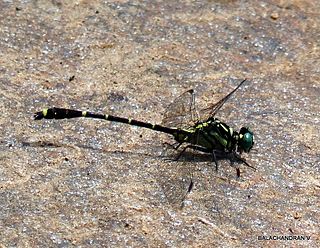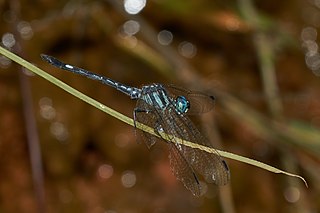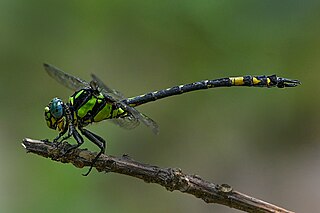
Esme longistyla is damselfly in the family Platycnemididae. It is commonly known as the Nilgiri bambootail. It is endemic to Western Ghats in India.

Lestes elatus is a species of damselfly in the family Lestidae, the spreadwings. It is known commonly as the emerald spreadwing. It is native to India, Thailand and Sri Lanka.

Copera marginipes, commonly known as the yellow bush dart, is a species of damselfly in the family Platycnemididae. It is native to Asia, where it is widespread and common.

Burmagomphus laidlawi is a species of dragonfly in the family Gomphidae. It is known only from the high altitude regions of Western Ghats of India.

Gomphidia kodaguensis is a species of dragonfly in the family Gomphidae. It is known only from the Western Ghats of India.

Heliogomphus promelas is a species of dragonfly in the family Gomphidae. It is endemic to the Western Ghats of India.

Merogomphus longistigma is a species of large dragonfly in the family Gomphidae. It is endemic to the forest streams of Western Ghats of India.

Microgomphus souteri is a species of small dragonfly in the family Gomphidae. It is endemic to the forest streams of Western Ghats of India.

Lamelligomphus nilgiriensis is a species of dragonfly in the family Gomphidae. It is endemic to the hill streams of Western Ghats of India. This species has been placed by many authors in Onychogomphus but should be included in Lamelligomphus following Fraser (1934), based on the shape of the male anal appendages.

Hylaeothemis apicalis, the blue hawklet, is a species of dragonfly in the family Libellulidae, endemic to India.

Dysphaea ethela, the black torrent dart, is a species of damselfly in the family Euphaeidae. The insect is named after Frederic Charles Fraser's wife, Ethel Grace Fraser (1881-1960), a constant companion of his collecting trips in India.

Idionyx travancorensis is a species of dragonfly in the family Synthemistidae. It is known only from the Western Ghats of India.

Davidioides martini, Syrandiri clubtail, is a species of dragonfly in the family Gomphidae. It is known only from the Western Ghats of India.

Megalogomphus hannyngtoni, is a species of dragonfly in the family Gomphidae. It is known only from the Western Ghats of India.

Megalogomphus superbus, is a species of dragonfly in the family Gomphidae. It is known only from the Western Ghats of India.

Merogomphus tamaracherriensis is a species of large dragonfly in the family Gomphidae. It is endemic to the forest streams of Western Ghats of India.

Nychogomphus striatus is a species of dragonfly in the family Gomphidae. It is endemic to the streams of Western Ghats of India. Reports from Nepal require further studies.

Macromia bellicosa is a species of dragonfly in the family Macromiidae. It is an endemic dragonfly and found only in Western Ghats in South India. It breeds in hill streams.

Macromia cingulata is a species of dragonfly in the family Macromiidae. It is an endemic dragonfly and found only in Western Ghats in India. It breeds in rivers.

Macromia irata is a species of dragonfly in the family Macromiidae. It is endemic to Western Ghats in India.





















